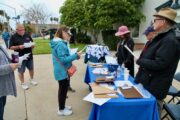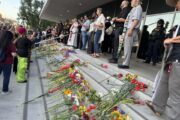Congregations can help the census have an accurate portrayal of their community. The USC Center for Religion and Civic Culture developed the following resources as a part of a Census 2010 outreach campaign designed to improve the count of low income and minority populations in Los Angeles.
These bulletin inserts and a Bible study curriculum can be adapted for future censuses as well.
This project targeted the populations served by the networks of religious leaders that CRCC has developed through several community-oriented projects. These networks included African American and Latino (both English and Spanish speaking) populations across the Los Angeles area. The project’s goal was to educate these leaders about the importance of participating in the upcoming census, such that they can then educate their congregants and communities.
Please consider the following tools, bulletin inserts and Bible study ideas, for use in congregations.
Insert these helpful statements within your Sunday bulletin for the Census.
Bulletin insert one:
Joseph and Mary participated in the Census! In New Testament times the Roman government conducted periodic counting of the people to assess the amount of tax their country should pay to the treasury of the Roman Empire. The 2010 Census is safe. By law, the Census Bureau cannot share your answers with anyone, including other federal agencies and law enforcement entities. Completing the 2010 Census form will shape the future for you, your church, your community and the country.
Bulletin insert two:
Moses participated in the Census! The Book of Numbers is an Old Testament book that traces the Israelites through their long period of wandering in the wilderness as they prepared to enter the Promised Land. Numbers takes its name from the two censuses of the people recorded in chapters 1 and 26. The 2010 Census is important. The 2010 Census is a historic event that will help shape our nation’s future for the next 10 years. With accurate census data, we can created a portrait of our nation’s growing population an determine what’s needed to better provide for everyone. Completing the 2010 Census form will shape the future for you, your church, your community and the country.
Bulletin insert three:
The biblical census was an official counting and registration of citizens; a property evaluation for tax purposes in early Rome. The New Testament mentions two censuses. At the time of Jesus’ birth, Joseph and Mary went to Bethlehem to be registered (Lk 2:1-5). The second Roman census was conducted to make an assessment of the property of Judea in A.D. 6. The 2010 Census is easy. In just 10 minutes, you can make a difference. One of the shortest census forms in history, the 2010 Census form asks 10 questions and takes about 10 minutes to complete! Completing the 2010 Census form will shape the future for you, your church, your community and the country.
A Seven Week Bible Study Series
Censuses Mentioned in the Bible
Week 1: By Moses and Aaron in the Wilderness (Ex. 30:11-16)
- Taxation of the Israelites for resources to build the tabernacle and to remind the people of their need for atonement
- No numbers given, but the people gave more than enough for the tabernacle (Ex. 36:4-7)
Week 2. By Moses in the Wilderness of Sinai (Num 1:2-3)
- Assessment of Israel’s military leaders strength in preparation for the conquest of Canaan
- Administered by leaders from each of åthe tribes
- Count totaled 603,550, not including Levites (Num. 1:46-53)
Week 3. By Moses in the plain of Moab (Num. 26:2)
- A second registration of Israel’s warriors following the wilderness experience of forty years
- Results used to apportion land in Canaan
- Managed by Elezar
- Count totaled 601,730 (Num. 26:51)
Week 4. By David (2 Sam. 24:1-10; 1 Chr. 21:1-6)
- Administered by David’s military leaders
- Took almost two years to complete
- Involved sin on David’s part and led to plague (2 Sam. 24:15; 1 Chr. 21:14)
- Totals given as 1.3 million (2 Sam. 24:9) and 1.57 million (1 Chr. 21:5), probably due to different modes of reckoning
Week 5. By Solomon ( 2 Chr. 2:17-18; compare 1 Kin. 5:13-18)
- A census of aliens living under his rule
- Patterned after David’s census
- Used to conscript labor for the construction of the temple and other projects (1 Kin. 5:13; 9:21)
- Count totaled 153,600 (2 Chr. 2:17)
Week 6. By Ezra and Nehemiah (Ezra 2)
- Taken upon the return of the Jews from exile in Babylon
- May have been used to verify those released for the return
- Involved a freewill offering from each family for the building of a temple (Ezra 2:68-69)
- Count totaled 42,360 Jews, 7,337 servants, and 200 singers (Ezra 2:64-65)
Week 7. By Augustus (Luke 2:1-3)
- Ordered by the Romans at the time of Jesus’ birth
- Probably used to inventory resources and needs of the empire, to raise money through taxation, and to determine where to allocate troops
- Total count not given in scripture



